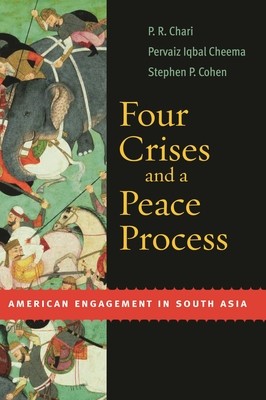
- We will send in 10–14 business days.
- Author: P R Chari
- Publisher: Brookings Institution Press
- ISBN-10: 0815713835
- ISBN-13: 9780815713838
- Format: 15.5 x 22.7 x 1.9 cm, softcover
- Language: English
- SAVE -10% with code: EXTRA
Reviews
Description
"
India and Pakistan, nuclear neighbors and rivals, fought the last of three major wars in 1971. Far from peaceful, however, the period since then has been ""one long crisis, punctuated by periods of peace."" The long-disputed Kashmir issue continues to be both a cause and consequence of India-Pakistan hostility. Four Crises and a Peace Process focuses on four contained conflicts on the subcontinent: the Brasstacks Crisis of 1986-1987, the Compound Crisis of 1990, the Kargil Conflict of 1999, and the Border Confrontation of 2001-2002. Authors P.R. Chari, Pervaiz Iqbal Cheema, and Brookings senior fellow Stephen P. Cohen explain the underlying causes of these crises, their consequences, the lessons that can be learned, and the American role in each. The four crises are notable because any one of them could have escalated to a large-scale conflict, or even all-out war, and three took place after India and Pakistan had gone nuclear. Looking for larger trends of peace and conflict in the region, the authors consider these incidents as cases of attempted conflict resolution, as instances of limited war by nuclear-armed nations, and as examples of intervention and engagement by the United States and China. They analyze the reactions of Indian, Pakistani, and international media and assess the two countries' decision-making processes. Fo ur Crises and a Peace Process explains how these crises have affected regional and international policy and evaluates the prospects for lasting peace in South Asia.
"EXTRA 10 % discount with code: EXTRA
The promotion ends in 20d.23:51:13
The discount code is valid when purchasing from 10 €. Discounts do not stack.
- Author: P R Chari
- Publisher: Brookings Institution Press
- ISBN-10: 0815713835
- ISBN-13: 9780815713838
- Format: 15.5 x 22.7 x 1.9 cm, softcover
- Language: English English
"
India and Pakistan, nuclear neighbors and rivals, fought the last of three major wars in 1971. Far from peaceful, however, the period since then has been ""one long crisis, punctuated by periods of peace."" The long-disputed Kashmir issue continues to be both a cause and consequence of India-Pakistan hostility. Four Crises and a Peace Process focuses on four contained conflicts on the subcontinent: the Brasstacks Crisis of 1986-1987, the Compound Crisis of 1990, the Kargil Conflict of 1999, and the Border Confrontation of 2001-2002. Authors P.R. Chari, Pervaiz Iqbal Cheema, and Brookings senior fellow Stephen P. Cohen explain the underlying causes of these crises, their consequences, the lessons that can be learned, and the American role in each. The four crises are notable because any one of them could have escalated to a large-scale conflict, or even all-out war, and three took place after India and Pakistan had gone nuclear. Looking for larger trends of peace and conflict in the region, the authors consider these incidents as cases of attempted conflict resolution, as instances of limited war by nuclear-armed nations, and as examples of intervention and engagement by the United States and China. They analyze the reactions of Indian, Pakistani, and international media and assess the two countries' decision-making processes. Fo ur Crises and a Peace Process explains how these crises have affected regional and international policy and evaluates the prospects for lasting peace in South Asia.
"

Reviews